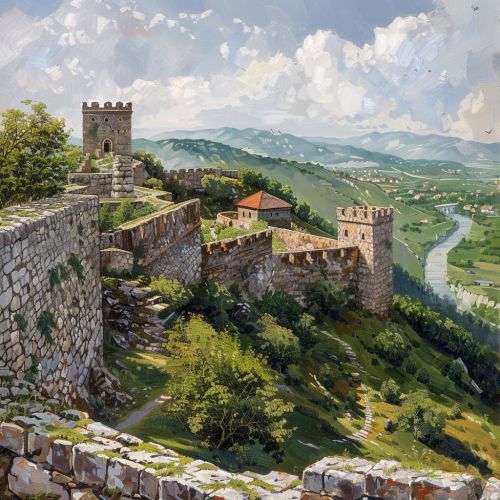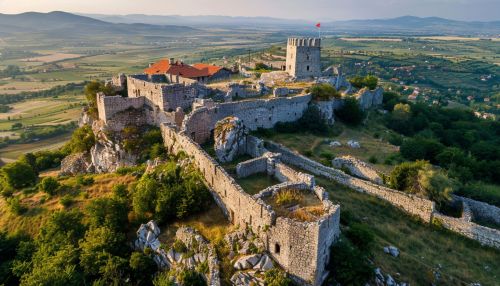History of the Serbs
Early History
The history of the Serbs, an ethnic group native to the Balkans, is deeply intertwined with the broader history of Southeastern Europe. The earliest mention of the Serbs dates back to the 6th century when they were part of the Slavic migrations into the Balkans. These migrations were part of a larger movement of Slavic tribes that reshaped the demographic and political landscape of the region.
Pre-Slavic Period
Before the arrival of the Slavs, the Balkans were inhabited by various ancient peoples, including the Illyrians, Thracians, and Dacians. The region was also influenced by the Roman Empire, which established several provinces, including Dalmatia, Moesia, and Pannonia. Roman rule brought significant cultural and infrastructural developments, many of which persisted even after the empire's decline.
Slavic Migration
The Slavic migration into the Balkans began in the 6th century, during the reign of the Byzantine Emperor Justinian I. The Serbs, along with other Slavic tribes, moved southward, settling in the territories of present-day Serbia, Montenegro, Bosnia and Herzegovina, and parts of Croatia. This period marked the beginning of the Slavicization of the Balkans, as the newcomers assimilated with the local populations and adopted Christianity.
Medieval Period
The medieval period was a time of significant political and cultural development for the Serbs. It saw the rise and fall of several Serbian states and the establishment of the Serbian Orthodox Church.
Early Serbian States
The first Serbian state, known as the Principality of Serbia, emerged in the 8th century under the leadership of the Vlastimirović dynasty. This early state was centered in the region of Raška and played a crucial role in the formation of Serbian identity. The principality maintained a delicate balance of power with the Byzantine Empire, often shifting alliances to preserve its autonomy.
The Nemanjić Dynasty
The Nemanjić dynasty, founded by Stefan Nemanja in the late 12th century, marked the golden age of medieval Serbia. Under the Nemanjić rulers, Serbia expanded its territory, reaching its zenith under Stefan Dušan, who proclaimed himself Emperor of the Serbs and Greeks in 1346. The Serbian Empire encompassed much of the Balkans, including parts of modern-day Greece, Albania, and Bulgaria.


The Nemanjić period was also a time of cultural flourishing. The construction of monasteries such as Studenica, Visoki Dečani, and Sopoćani showcased the distinctive Serbian Orthodox architecture and became centers of religious and cultural life. The Serbian Orthodox Church was granted autocephaly in 1219, further solidifying the national identity.
Decline and Ottoman Conquest
The decline of the Serbian Empire began after the death of Stefan Dušan in 1355. Internal strife and external pressures weakened the state, leading to its fragmentation into smaller principalities. The decisive blow came with the Battle of Kosovo in 1389, where the Serbian forces, led by Prince Lazar Hrebeljanović, faced the Ottoman Turks. Although the battle ended inconclusively, it marked the beginning of Ottoman dominance in the region.
By the mid-15th century, most of Serbia had fallen under Ottoman rule. The fall of Smederevo in 1459 marked the end of the medieval Serbian state, ushering in a period of Ottoman occupation that would last for several centuries.
Ottoman Period
The Ottoman period was a time of significant hardship and transformation for the Serbian people. Despite the challenges, Serbian culture and identity persisted, often centered around the Orthodox Church.
Life under Ottoman Rule
Under Ottoman rule, the Serbs were subjected to heavy taxation and various forms of oppression. The devshirme system, which involved the forced recruitment of Christian boys into the Ottoman military, was particularly resented. Many Serbs fled to the mountains or migrated to neighboring regions to escape Ottoman control.
Despite these hardships, the Serbian Orthodox Church played a crucial role in preserving national identity. Monasteries and churches served as centers of education and cultural preservation. The Patriarchate of Peć was restored in 1557, providing a degree of religious and cultural autonomy.
Uprisings and Resistance
The Serbs never fully accepted Ottoman rule, and numerous uprisings occurred throughout the centuries. The First Serbian Uprising (1804-1813) and the Second Serbian Uprising (1815) were pivotal in the struggle for independence. Led by figures such as Karađorđe Petrović and Miloš Obrenović, these uprisings eventually led to the establishment of the autonomous Principality of Serbia in 1817.
Modern Period
The modern period in Serbian history is marked by the struggle for full independence, the formation of the Kingdom of Serbia, and the turbulent events of the 20th century.
Independence and the Kingdom of Serbia
The Treaty of Berlin in 1878 recognized Serbia as an independent state. The subsequent decades saw significant political and economic development. In 1882, Serbia was proclaimed a kingdom under King Milan I of Serbia. The country pursued a policy of modernization and expansion, aiming to unite all Serbs within a single state.
Balkan Wars and World War I
The early 20th century was a period of intense conflict in the Balkans. Serbia played a central role in the Balkan Wars (1912-1913), which aimed to liberate territories from Ottoman control. The success in these wars expanded Serbia's territory but also heightened tensions with neighboring states.
The assassination of Archduke Franz Ferdinand in Sarajevo in 1914, carried out by the Bosnian Serb nationalist Gavrilo Princip, triggered World War I. Serbia was invaded by Austro-Hungarian forces, leading to immense suffering and loss of life. Despite these challenges, Serbia emerged on the victorious side, contributing to the formation of the Kingdom of Serbs, Croats, and Slovenes in 1918, later known as Yugoslavia.
World War II and Socialist Yugoslavia
World War II brought further devastation to Serbia. The country was occupied by Axis forces, and a brutal conflict ensued between various resistance groups, including the royalist Chetniks and the communist Partisans led by Josip Broz Tito. The Partisans eventually emerged victorious, leading to the establishment of a socialist Yugoslavia in 1945.
Under Tito's leadership, Yugoslavia pursued a policy of non-alignment and relative independence from both the Soviet Union and the Western bloc. Serbia, as one of the six republics within Yugoslavia, experienced significant industrialization and modernization during this period.
Breakup of Yugoslavia and Modern Serbia
The breakup of Yugoslavia in the early 1990s was a tumultuous period for Serbia. The country faced international isolation and economic hardship due to its involvement in the Yugoslav Wars. The Dayton Agreement in 1995 brought an end to the conflict in Bosnia and Herzegovina, but tensions remained high.
In 2006, following a referendum, Montenegro declared independence, leading to the dissolution of the State Union of Serbia and Montenegro. Serbia became an independent state once again. The subsequent years have seen efforts to integrate into the European Union and stabilize the economy.
Culture and Heritage
Serbian culture is a rich tapestry of influences, reflecting its complex history and diverse population. The Serbian Orthodox Church, folklore, and traditional music and dance play a significant role in the national identity.
Religion
The Serbian Orthodox Church is a cornerstone of Serbian culture and identity. It has played a crucial role in preserving national consciousness during periods of foreign domination. Important religious sites include the Monastery of Hilandar on Mount Athos and the Cathedral of Saint Sava in Belgrade.
Folklore and Traditions
Serbian folklore is rich with epic poetry, traditional music, and dance. The Gusle, a single-stringed instrument, is often used to accompany epic poems that recount historical events and heroes. Traditional dances such as the Kolo are performed at various celebrations and festivals.
Language and Literature
The Serbian language, written in both the Cyrillic and Latin alphabets, is a vital aspect of cultural identity. Serbian literature has a long tradition, with notable figures such as Vuk Karadžić, who reformed the Serbian language and collected folk literature, and Ivo Andrić, a Nobel Prize-winning author.
